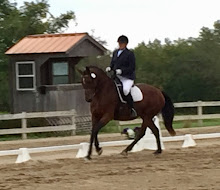Infuencing the walk and trot is fairly straight forward. Influencing the canter is another matter. The canter can be influenced the most at the point of engagement.
First and formost is finding the point of engagement. When the horse canters he starts out with his outside hind leg followed by the diagonal pair of the inside hind and outside front and finishing with the inside front leg. At the point where the inside front leg hits the ground the rider will find their hips in the forward position. This is the point of engagement or where most of the influence happens in the canter. It is at this point where the rider must apply leg to ask for another canter stride and can apply a half halt in the rein for collection.
First lets talk about longitudinal influence. It is common for a horse to either canter too quickly or too slowly, most of them do not land just right in the longitudinal balance. Count your lucky stars if they do!
A horse that canters too quickly could use help with balance. To help a horse balance and slow down its canter, the rider should resist with the muscles in their torso and lower back during the time the horse is swinging them forward and then half halt in the reins when their hips have been fully swung forward. Along with the half halt the rider applies lower leg to the horse to ask for another stride. The half halt and the leg happen at the same moment. Then when your hips are swinging back freely follow with your hips. This will help your horse slow down and balance better. Be very careful to only flex your horses neck slightly, if you overbend your horses neck, your horse will have trouble balancing longitudinally.
As your horse progresses and is later in his training expected to have a more uphill balance to his canter, you will want to modify your upper body support of his balance a little. For example, when your horse canters uphill, your hips will not swing back past your shoulders, they will swing from the vertical line forward. You can help your horse further collect by only allowing your hips to swing as far back as your shoulders. So your torso swings forward and upward to help your horse stay collected. It feels like you are doing situps but the horse is the part that comes forward and up in his canter.
For a horse that is too slow or sticky in its canter, the rider can push at the point of engagement and then swing their hips stronger than the horse swings them. The hip is in addition to the leg, not instead of it.
A few other points of interest is that when asking the horse to turn in the canter, the rider must ask at the point of engagement when the rider has its leg on for another stride. So when asking for a turn, the rider asks when his leg is on the horse. This is the most effective way to ask. Asking for a turn while confirming forward makes for a better turn.
When asking for a down transition, it is also best to ask at the point of engagement. If the rider asks at that moment the horse swings itself into its best balance as it comes down to the trot, walk or halt.
Happy riding!
Thursday, April 14, 2011
Subscribe to:
Post Comments (Atom)

No comments:
Post a Comment
Note: Only a member of this blog may post a comment.